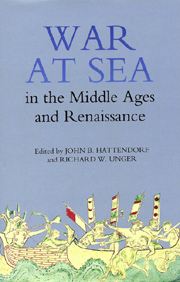Book contents
- Frontmatter
- Contents
- List of illustrations
- List of Contributors
- Preface
- Acknowledgements
- Introduction: Theories of Naval Power: A. T. Mahan and the Naval History of Medieval and Renaissance Europe
- I Northern Europe
- II Southern Europe
- III Sixteenth and Early-Seventeenth-Century Europe
- The Navies of the Medici: The Florentine Navy and the Navy of the Sacred Military Order of St Stephen, 1547–1648
- The State of Portuguese Naval Forces in the Sixteenth Century
- Naval Power in the Netherlands before the Dutch Revolt
- Naval Power and Control of the Sea in the Baltic in the Sixteenth Century
- The New Atlantic: Naval Warfare in the Sixteenth Century
- Conclusion: Toward a History of Medieval Sea Power
- Index
- Titles in the series
The Navies of the Medici: The Florentine Navy and the Navy of the Sacred Military Order of St Stephen, 1547–1648
from III - Sixteenth and Early-Seventeenth-Century Europe
Published online by Cambridge University Press: 05 April 2013
- Frontmatter
- Contents
- List of illustrations
- List of Contributors
- Preface
- Acknowledgements
- Introduction: Theories of Naval Power: A. T. Mahan and the Naval History of Medieval and Renaissance Europe
- I Northern Europe
- II Southern Europe
- III Sixteenth and Early-Seventeenth-Century Europe
- The Navies of the Medici: The Florentine Navy and the Navy of the Sacred Military Order of St Stephen, 1547–1648
- The State of Portuguese Naval Forces in the Sixteenth Century
- Naval Power in the Netherlands before the Dutch Revolt
- Naval Power and Control of the Sea in the Baltic in the Sixteenth Century
- The New Atlantic: Naval Warfare in the Sixteenth Century
- Conclusion: Toward a History of Medieval Sea Power
- Index
- Titles in the series
Summary
AT the beginning of the fifteenth century, the Republic of Florence obtained its long-awaited connection with the Tyrrhenian Sea, when it conquered Pisa in 1406. In 1421, it expanded further when it acquired the coastal towns of Leghorn and Porto Pisano from the Genoese. Before long, Florentine galleys began to ply the Mediterranean and to push through the Strait of Gibraltar, trading as far away as Flanders and England. In the last quarter of the century, Florence, whose government was by now largely run by the Medici family, was engaged in a war against the kingdom of Naples and the Papal States. The huge expenses sustained during this conflict, the danger of piracy, and the competition from Basque, Catalan, English and French merchant ships, which could import and export goods from the Florentine State at costs notably lower than those of the Florentine galleys, forced the Florentines to disarm their fleet.
In 1537, Cosimo I de' Medici became Duke of Florence and began a foreign policy aimed at increasing his own dominions and reducing the influence of Emperor Charles V over Florence. Cosimo I achieved his first success in 1543, when the Emperor relinquished the fortresses of Leghorn and Florence. The duke was aware that he could not withdraw completely from the protection of the Habsburgs, so instead he tried to alter the alliance between Florence and the Empire to create a relationship whereby he became the key supporter of the Habsburgs' presence in the Italian peninsula.
- Type
- Chapter
- Information
- War at Sea in the Middle Ages and the Renaissance , pp. 169 - 186Publisher: Boydell & BrewerPrint publication year: 2002

